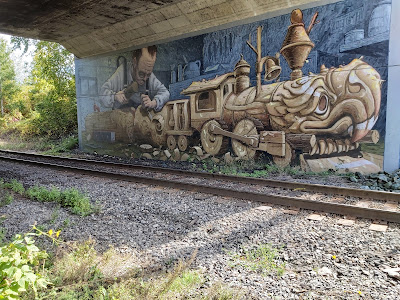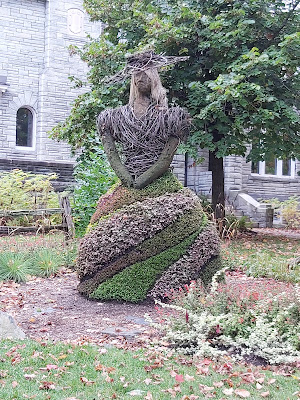We had a exciting time getting to Sherbrooke. Our visit there was on the last day of a 5-day trip. They say that it is the adventure of getting there that makes the trip. Well, I am not sure if would want to experience this trip again. It started out great. We first went to the Cosmodome in Laval, Quebec. We were the only ones there so we had the whole place to ourselves and we could take our time. We played several games where we learned through interactive play about the solar system, space travel and the moon. It was very interesting and it was like going on a mission. We also meandered through a variety of exhibits.
The Cosmodome
You can't miss the place.
It's the place with the rocket
in front.
Virtual Missions: Through short films and interactive games, take
up the challenges of the space explorers in a futuristic setting. We
did all three missions.
We walked through many space related exhibits.Saint-Louis-du-Ha! Ha!
We had to stop for a photo op. What is in a name? Well, Saint-Louis-du-Ha! Ha! is not meant to be funny. The word "Ha-Ha" is an archaic French word meaning impasse. Interesting fact: The municipality established a Guinness World Record for the most exclamation marks in a town name. There are other towns using ha-ha in Quebec as well such as Baie des Ha! Ha! and Riviere Ha! Ha!
No matter the meaning behind the name, it made us smile hence the photo op.
A Side Trip to the Canada-U.S border:
Estcourt Station, Maine is one of those unusual towns on the Canada-U.S. border that found itself in controversy over the years. We learned about it during our travels in New Brunswick and were determined to visit it while in Quebec.
The town
was originally thought to be entirely within Canada until the early 20th
century when a treaty was signed between the two countries to resolve some
border issues. At that time, the border
was shifted slightly, which put some of the houses into the American side. In the case of 8 houses, the border goes
through the house! The
American slice of the neighborhood eventually became known as Estcourt Station,
which was the designation affixed to the U.S. border post, but the community
functioned as one place — “Estcourt” — and residents moved about with little
regard to what country they were in.

Then, as now, border officers from both countries worked daytime hours five days a week, but when they went home for the evening or weekend, they didn’t put up a gate the way the Americans do today (the Canadian station has no gate, and a sign instructs drivers to use an outdoor telephone to call an officer on duty in Clair, New Brunswick). No one cared that people would cross after hours to buy cigarettes at Magasin General Americain, the store that operated out of a house, or to fuel up at Gaz-bar Ouellette, about 60 yards inside U.S. territory, off Rue de la Frontière.
Here is the Kelly Rapids footbridge, which links
Pohénégamook and Estcourt Station, was once nicknamed Tobacco Road for all the
locals from the Canadian side who crossed it to buy American cigarettes by the
garbage-bagful at Magasin General.
A border marker which shows Canada on one side and United States of the other.

After the 9/11 terrorist attacks in New York City in 2011,
the U.S. cracked down on border crossings everywhere and at Estcourt Station,
it meant that the few residents that lived there could no longer freely cross
over to Pohénégamook, Quebec for
groceries or other things they could not buy.
Similarly, Canadians who crossed to buy the cheaper gas at Estcourt’s
only gas station had to report to both U.S. and Canadian customs in order to do
so. Because of the “chill” these new restrictions
caused, as well as the arrests of a couple of people who failed to report to
Customs, cross-border commerce was greatly reduced and the town’s only store
and gas bar closed.
During
our trip through town, we did not go further south than the main road, just on
the U.S. side, and visited the Peace Bridge and some markers indicating the
original and current border markers. We
did not report to customs and there were no signs of anyone official on either
side of the border.
Finally in Sherbrooke
Finally, we arrived in Sherbrooke, on a bright and sunny day. Just right for a stroll through the town to see the flower sculptures and many wall murals which adorn the walls in town depicting the history of the town. Here are some of my favourites.
Just outside the information office.
"A pot of flowers"
Again outside the information office

The Upper Mills
The walls of the current information centre is covered with murals. The location of the mural was once known as the "Upper Mills" and the murals harken back to the businesses that were located here in 1867. Located about 100m from the building, the stairway that leads to the Magog River Gorge takes us back to the period.
Busy parks are filled with art.
If you position yourself just right, these pillars just right, it looks like one piece of floral art.
The other side is a photo of the area.
A large "rubber" duckie
A bridge over a former rail line
Carver building a train on the wall of the underpass.
A closer look through a gap in the pedestrian walkway.
Laundry Day: This is real life. To some, the art of hanging
clothes on the line is a real skill.
We Are In The Movies
This fresco pays homage to many builder promoters and creators who play a role behind and in front of the screen. Sherbrooke movie history is almost as long as cinema's. In December 1896, the residents of Sherbrooke could watch the cinematographic projections provided by the Lumiere brothers. Since then, several movie theatres have been the meeting places for Sherbrooke's cinema lovers, including the Cinema de Paris, the one illustrated here which closed its doors in 1987. The original site was located a few short steps from the mural's location.
The Fifth Element
This calm and relaxing mural symbolises the four elements found in nature -- fire, earth, water and air. Spectators represent the fifth element. Each visitor is invited to immerse themselves in this peaceful environment, becoming an integral part of this mural.
Emergency services: the helpful policeman
Tradition and Prevention
The two photos above are a part of a mural which honours the firemen and policemen who have been keeping the people of Sherbrooke safe since 1852. The west wall of the building is a symbolic representation of the old central fire station, featuring 25 characters.
Canada Games 2013
This mural is a collective effort, produced with the participation of 111 local and national artists from all 13 provinces and territories participating in the Sherbrooke 2013 Canada Summer Games... in other words, artists from sea to sea. This mural project is made up of 224 panels assembled in a single composition that, once put together, represents a single trompe-l'oeil image.
#Sherbylove
This mural's essence is 15 feet wide and our era needs it more than ever, rabu, liebe, alhab, ai, agape, lubov, pyara, amor, amour...love! this is the open-minded and universal symbol we want people to remember about Sherbrooke. #Sherbylove is the reaction of Sherbrooke's residents love and attachment to their city.
Plants sculpted into the shape of cacti.
An octopus in the middle of the street.
The octopus from a different angle.
Nice curly legs!
Signage for businesses also draw your eye.
A garden gnome in the middle of the street?
All along the street were these plants hanging from the lamp posts.
They remind me so much of jelly fish. Lovely!
This street art (graffiti) I found down an alleyway.
The art is just as good as the wall murals. I don't
know what it means but...
Nekitotegwak
This mural shows the junction of the Magog and St-Francois rivers as the Abenkis, the indigenous people of the area, would have once seen it. Nekitotegwak means "where the rivers meet". This is where Sherbrooke's first settlers made their home.
Murals are everywhere. Even on water towers.
Sherbrooke 2002 Bicentennial
It was on the 200th anniversary of the founding of the city of Sherbrooke that the first trompe-l'oeil mural was inaugurated. This looks as if time stood still on the sunny afternoon of June 2, 1902. Some 23 characters are realistically represented.
CHLT-TV 50 Years of Looking At It Our Way
CHLT-TV (Channel 7) celebrated its 50th anniversary on August 12, 2006. In 1954, Senator Jacob Nicol obtained a license to operated a bilingual television station in Sherbrooke. The mural features 30 well-known cultural personalities from yesterday and today, brought together to celebrate the 50th anniversary.
These bright yellow flowers topped the entrance archway at a retirement home.
A cheerful welcome!
100 Years At Your Service
This mural commemorates the centennial of the municipalization of electricity in Sherbrooke. On May 1st, 1908, the City of Sherbrooke acquired the Frontenac power plant and the assets of the Power Light & Heat Co., the sole energy producer and distributor at that time. After a fourth referendum on the issue, and after nearly six years of work by city councillors, this public service was born, making Hydro-Sherbrooke one of the city's proudest symbols.
At this point, we crossed a bridge over the torrent of water
near the hydro plant.
We then walked a board walk in the shade of trees along the river.
Returning to our van, we drove over to Domaine Howard. Although it was late in the season, the gardens and walkways were still beautiful. The Domaine-Howard Park site was the residence of the Howard family, whose contribution to the City of Sherbrooke on the economic, political and urban levels is significant.
Each year, 60,000 annuals and over a thousand perennials are used to create a peaceful place of discovery. Also 50,000 plants are used to create various Mosaicultures that beautify the park. What is mosaiculture? It is the horticultural art of creating giant topiary-like sculptures using thousands of annual bedding plants to cover steel armature forms. Such as the one below:
A mosaiculture of Dame Howard set in front of the residence.
The pond is the setting of more sculptures.
Frog crossing sign sets the scene.
A frog about the cross the road
Another frog on the other side of the road.
"Why did the frog cross the road?"
Answer: Because he wanted to see his "flat" mate. (Obviously the driver
didn't take note of the frog crossing sign -- see above)
A frog hiding in the pond.
Amongst the lily pads.
A metal sculpture of lily pads
A metal sculpture of birds in flight.
Colourful lily pads in the pond add to the enchantment of the park.
It was a lovely end to our time in Sherbrooke. Murals, mosaicultures, flowers and other art forms made the day an interesting way to view a City and discover its history. I am sure that many towns could tell their historical story the same way.





















































No comments:
Post a Comment